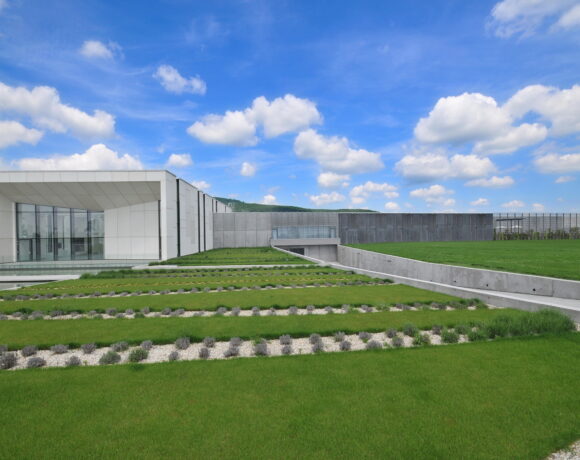Amos Rex is an art museum named after the publisher and patron Amos Anderson (1878 – 1961) and located in the heart of the city of Helsinki, opposite to the Parliament and the Kiasma Museum designed by Steven Holl. It was inaugurated in 2018 on a project by the JKMM studio, but the silhouette of the building is not visible: the square that houses it looks like an immense playground, with dunes and humps that hide the skylights built to give light to the rooms below. In fact, Amos Rex is an entirely underground structure and access is through Lasipalatsi, a building from 1936, and renovated by Katja Savolainen, precisely to make it functional to the new museum project. The total area of Amos Rex is 6,230 square meters, with a 2200 square meters exhibition hall without columns.
We would like to point out that Amos Anderson’s summer residence in Söderlångvik Manor (about 170 km west of Amos Rex), intended as a museum, is also undergoing complete renovation and is scheduled to reopen in spring 2021. The site is renowned for the peace and quiet it infuses, thanks to the apple orchards that surround it and the lush forests that extend to the promontory of Purunpää.
Amos Rex Museum has a schedule of three exhibitions every year. The contents are the most different and look not only at contemporary art, but also at the past or new technologies. Obviously, there is no lack of special attention for Finnish artists. The program is planned by a well-assorted team of curators, under the guidance of Kai Kartio, director of the museum.
Now, at the end of the exhibition on ancient Egypt, the museum is planning, from 22 September 2021 to 16 January 2022, a large retrospective dedicated to the work of Bill Viola, and this is the first presentation of this pioneer of video art in Finland.
American Bill Viola (born in 1951) is one of the most acclaimed artists of our time. Over the course of his forty-five-year career, he has developed a visionary use of his means of expression, without forgetting the ability to dialogue with the history of images, and focusing on the key themes of human existence: life and death, spirituality and introspection. Among the works of the past from which he drew inspiration for his video installations we remember “The Annunciation” by Dieric Bouts, “The Adoration of the Magi” by Andrea Mantegna and the “Christ mocked” by Hieronymus Bosch. In the words of the author emerge the salient aspects that motivated him and that also allude to the translation between religion and secular spirituality of which the museum is (in the contemporary age) in some way the custodian: “Every time you are creating something that touches the inner self of the human being, everything that emerges from ourselves from a genuine and unguarded place is ultimately a sacred act, no matter if you follow a religion or not. All the things that surround us derive from the inspiration to transform the material world into our inner vision. So, in some ways, museums function as religious and spiritual places”.
His works combine refined technical execution with powerful emotional expression. Words suitable for his work are: oscillation, laceration, simultaneous exultation, balance between taking and dispossessing, between joy and mourning. But the exultation should not be seen for what it is represented, but as an acute awareness of fragility; it cannot be eagerly awaited for the possible benefits of tomorrow, as much as the search for the original stratification to transform it into an armor against death. In this sense, the underground environments of Amos Rex seem to be made on purpose to lead to recollection and meditation, welcoming these great projections that will immerse the viewer in an engaging and enveloping flow of images, given that in any case the fulcrum of any religious or spiritual experience refers to the intimacy of the single individual, to a personal interior vision.
Finally, as a curious anecdote we recall that Bill Viola worked in Florence, from 1974 to 1976, as technical director at Art / tapes / 22, a project led by Maria Gloria Bicocchi from 1972 to 1976, that was one of the four Italian production centers of artistic videotapes.
Fabio Fabris
Info:
Amos Rex
Mannerheimintie 22–24
00100 Helsinki, Finlandia
museum@amosrex.fi
 Interior detail of Amos Rex Art Museum (project by JKMM Architects), ph Tuomas Uusheimo, courtesy Amos Rex
Interior detail of Amos Rex Art Museum (project by JKMM Architects), ph Tuomas Uusheimo, courtesy Amos Rex
 External view of the Bio Rex (building that serves as the entrance to the Museum), ph Tuomas Uusheimo, courtesy Amos Rex
External view of the Bio Rex (building that serves as the entrance to the Museum), ph Tuomas Uusheimo, courtesy Amos Rex
 Bill Viola, The Sleepers (detail), 1992. Video installation. Photo courtesy Musée d’art contemporain de Montréal, Quebec, Canada
Bill Viola, The Sleepers (detail), 1992. Video installation. Photo courtesy Musée d’art contemporain de Montréal, Quebec, Canada

is a contemporary art magazine since 1980






NO COMMENT